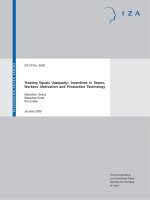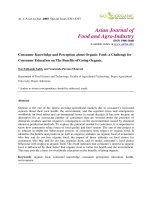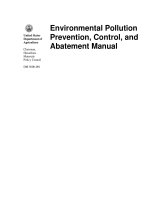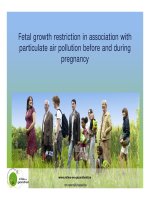Ecological Orbits: How Planets Move and Populations Grow potx
Bạn đang xem bản rút gọn của tài liệu. Xem và tải ngay bản đầy đủ của tài liệu tại đây (2.53 MB, 183 trang )
Ecological Orbits:
How Planets Move
and Populations Grow
LEV GINZBURG
MARK COLYVAN
OXFORD UNIVERSITY PRESS
Ecological Orbits
This page intentionally left blank
Ecological Orbits
How Planets Move
and Populations Grow
LEV GINZBURG
MARK COLYVAN
1
2004
1
Oxford New York
Auckland Bangkok Buenos Aires Cape Town Chennai
Dar es Salaam Delhi Hong Kong Istanbul Karachi Kolkata
Kuala Lumpur Madrid Melbourne Mexico City Mumbai Nairobi
S
˜
ao Paulo Shanghai Taipei Tokyo Toronto
Text Copyright © 2004 by Applied Biomathematics
Artwork by Amy Dunham © 2002 Applied Biomathematics
Published by Oxford University Press, Inc.,
198 Madison Avenue, New York, New York 10016
www.oup.com
Oxford is a registered trademark of Oxford University Press
All rights reserved. No part of this publication
may be reproduced, stored in a retrieval system, or transmitted,
in any form or by any means, electronic, mechanical,
photocopying, recording, or otherwise, without the prior
permission of Oxford University Press.
Library of Congress Cataloging-in-Publication Data
Ginzburg, Lev R.
Ecological orbits: how planets move and populations grow /
Lev Ginzburg, Mark Colyvan.
p. cm.
Includes bibliographical references (p. ).
ISBN 0-19-516816-X
1. Population biology. 2. Ecology. I. Colyvan, Mark. II. Title.
QH352.G55 2003
577.8'8—dc21 2003048690
135798642
Printed in the United States of America
on acid-free recycled paper
To Tatyana (1946–2000)
Difficulty in imagining how theory can adequately describe nature is
not a proof that theory cannot.
—Robert MacArthur (1930–1972)
Neruda: Le metafore? . . . Quando parli di una cosa, la paragonono
ad un’ altra. . . .
Postino: É semplice! Perchè questo nome é cosí complicato?
[Neruda: Metaphors? . . . It’s when you speak of one thing, com-
paring it to another. . . .
Postino: That’s simple! Why do they use such a complicated name?]
—Dialogue between the characters Pablo Neruda
and the postman in the movie Il Postino (1995)
Preface
The main focus of this book is the presentation of the “inertial”
view of population growth. This view provides a rather simple
model for complex population dynamics, and is achieved at the
level of the single species, without invoking species interactions.
An important part of our account is the maternal effect. Invest-
ment of mothers in the quality of their daughters makes the rate
of reproduction of the current generation depend not only on the
current environment but also on the environment experienced
by the preceding generation.
The inertial view is a significant departure from traditional
ecological theory, which has been developing within the Lotka–
Volterra framework for close to a century. One way to see this
departure is to focus attention away from the growth rate as the
sole variable responding to the environment, and toward “ac-
celeration,” or the rate of change of the growth rate between
consecutive generations. More precisely, our suggestion is that
population growth is a second-order dynamic process at the
single-species level, and the second-order character is not nec-
essarily the result of species interactions. If the inertial view of
population growth proves correct, a great deal of current theory
on population growth will need to be rethought and revised.
As will become clear, our inspiration for looking at ecology
in the way we do comes from similar moves in physics—in par-
ticular, the move from Aristotelian to Newtonian physics. So let
us say a few words in defense of our apparent “physics envy.”
Many biologists and ecologists find deference to physics, as the
viii Preface
Alfred James Lotka (1880–1986)
science to which all other sciences must aspire, somewhat dis-
tasteful. Those who find this deference to physics unreasonable
are generally concerned by the inappropriateness of the meth-
ods of physics to other branches of science. They suggest that
biology, for example, would be better served if biologists did
biology instead of trying to mimic the methods and successes
of physics. We agree that the methods of the various sciences
are quite different and that, in general, the methods of physics
are of little use to biologists. But this does not mean that the
various branches of science cannot take inspiration from one
another.
Preface ix
Vito Volterra (1860–1940)
The inspiration here is metaphorical, not mechanical. We see
an abstract connection between a certain innovation in the devel-
opment of physics around the time of Galileo and an analogous
way to approach population growth. We are not suggesting any
mechanistic similarities between the ways in which populations
grow and the ways planets move. At the same time, we are not
trading in mere metaphors. Although the inspiration for looking
at ecology in the way we do comes from metaphorical connec-
tions with physics, these connections can, and will, be spelled
out via the mathematics employed in the respective theories we
present.
x Preface
Down through the ages, metaphors and analogies have been a
common device for generating new and fruitful ideas in science.
We hope, in the end, you will agree with us that the predominant
analogy of this book—the analogy between inertial population
growth and classical mechanics—is, at the very least, interesting.
This analogy helps motivate and shed light on a fruitful way of
thinking about population growth. Of course, eventually, the
inertial theory of population growth needs to stand on its own
merits, and we hope we have contributed to that enterprise as
well, but at the same time, we feel no shame in revealing the
more poetic beginnings of our thinking on this subject.
Appreciations
First, we thank Kluwer Academic Publishers and Blackwell Pub-
lishers for permission to reproduce material from our articles
(Colyvan and Ginzburg 2003a, 2003b). Material from chapters 1
and 3 originally appeared in Biology and Philosophy, and material
from chapter 2 originally appeared in Oikos. The copyrights for
the material in question remain with Kluwer and Blackwell, re-
spectively.
Next, we owe appreciation to Resit Akçakaya, André Coelho-
Levy, Amy Dunham, Dan Dykhuizen, Scott Ferson, Doug Fu-
tuyma, Alex Ginzburg, Janos Hajagos, Charlie Janson, Stephan
Munch, Bertram Murray, Yamina Oomen, Helen Regan, Justin
Roman, Marina Shokhor, Larry Slobodkin, Justine Tietjen, and
George Williams for their attendance at, and valuable contribu-
tions to, a series of seminars in Old Field, New York, in 2001
devoted to the topic of this book.
We are indebted to Peter Abrams, Resit Akçakaya, Alan
Berryman, Rudy Boonstra, Leah Ceccarelli, Amy Dunham,
Scott Ferson, David Goodstein, Chris Jensen, John True, Troy
Tucker, and Peter Turchin for reading earlier drafts of the whole
book manuscript, and for their insightful comments, criticisms,
and suggestions. We are also indebted to Roger Arditi, John
Damuth, Pablo Inchausti, John Kadvani, Elizabeth Milliman,
Helen Regan, Larry Slobodkin, and Justine Tietjen for reading
and commenting on drafts of various sections of the book.
Many of the ideas in this book have been developed over a
number of years, and many conversations and exchanges with
xii Appreciations
various people have helped clarify our thinking on these mat-
ters. These people include Evelyn Fox Keller, Alan H
´
ajek, Greg
Mikkelson, Kim Sterelny, and Bill Wimsatt.
We are also indebted to Carol Booth for her help with the
index, to Amy Dunham for her artwork, to Elizabeth Milliman
for data analysis and editorial assistance, to Herb Mummers for
editorial and technical assistance, to Edward Beltrami and Patrícia
Maragliano for translating and transcribing the dialogue from Il
Postino, and to John Damuth and Justin Roman for help with the
book title.
Finally, Lev Ginzburg would like to acknowledge a huge debt
to Tatyana Ginzburg. For 30 years Tatyana argued that it was
a mistake to use physical analogies in advancing an ecological
theory. As even a casual reader of this book will notice, Lev
ignored her advice. But her advice was not in vain. Her challenge
to the use of physical analogies resulted in considerable reflection
on the particular analogies employed in this book and, more
generally, on the nature and role of analogy in science. This, in
turn, resulted in a much clearer book than what would have been
written without Tatyana’s criticisms. This book is dedicated to
Tatyana and her well-intentioned advice.
Contents
1 On Earth as It Is in the Heavens 3
1.1 How Planets Move 4
1.2 How Populations Grow 6
1.3 Metaphors and the Language of Science 8
1.4 Inertial Population Growth 9
2 Does Ecology Have Laws? 11
2.1 Ecological Allometries 12
2.2 Kepler’s Laws 21
2.3 What Is a Law of Nature? 26
2.4 Laws in Ecology 30
3 Equilibrium and Accelerated Death 34
3.1 Accelerated Death 35
3.2 Galileo and Falling Bodies 36
3.3 The Slobodkin Experiment 39
3.4 Falling Bodies and Dying Populations 42
3.5 The Meaning of Abundance Equilibrium 43
3.6 The Damuth Allometry 46
3.7 A Harder Question 48
xiv Contents
4 The Maternal Effect Hypothesis 49
4.1 Inertial Growth and the Maternal Effect 50
4.2 The Missing Periods 52
4.3 The Calder Allometry 57
4.4 The Eigenperiod Hypothesis 59
4.5 What Can Be Done in the Laboratory 62
5 Predator–Prey Interactions and
the Period of Cycling 64
5.1 An Alternative Limit Myth 65
5.2 Prey-Dependent versus Ratio-Dependent
Models 66
5.3 The Fallacy of Instantism 70
5.4 Why Period Travels Bottom Up 74
5.5 Competing Views on Causes and Cyclicity 78
6 Inertial Growth 83
6.1 The Implicit Inertial-Growth Model 83
6.2 Parametric Specification 90
6.3 Malthusian Invariancy 95
6.4 What Is and What Is Not Analogous 100
7 Practical Consequences 104
7.1 Theoretical and Applied Ecology 104
7.2 Managing Inertial Populations 106
7.3 Rates of Evolution 111
Contents xv
7.4 Risk Analysis 113
7.5 The Moral 114
8 Shadows on the Wall 117
8.1 Plato’s Cave 118
8.2 Evidence and Aesthetics 120
8.3 Overfitting 123
8.4 A Simplified Picture of Population Ecology 125
Appendix A: Notes and Further Reading 133
Appendix B: Essential Features of the Maternal
Effect Model 143
Bibliography 151
Index 161
This page intentionally left blank
Ecological Orbits
This page intentionally left blank
One
On Earth as It Is in the Heavens
Populations grow and decline; planets roll relentlessly around the
sun. On the face of it, planets and populations have nothing to
do with one another. Indeed, they are studied by completely
different branches of science. Planets are studied by a branch of
physics—astronomy; populations of living organisms are studied
by a branch of biology—population ecology. And these two dis-
ciplines have little in common. Any suggestion that one theory
describes both planetary motion and population growth is surely
misguided.
There are some similarities between planets and populations,
however. For a start, the laws of nature are meant to hold ev-
erywhere in the universe. We expect planets in far-off galaxies
to be governed by the same natural laws as our own Earth. And
we expect theories of population growth to hold for whatever
strange creatures inhabit those far-off planets, just as these theo-
ries hold for rabbits, bacteria, and humans here on Earth. Second,
both planets and populations are capable of periodic behavior.
Planets trace out elliptical orbits around the sun and (more or less)
repeat these orbits, taking (more or less) the same period of time
to complete each cycle. The abundance of certain populations
can also rise and fall in a periodic way, so that the number of
organisms cycles between extreme values over some (more or
less) fixed period of time. Of course, the mechanisms in each
case are totally different, but at some level there are striking sim-
ilarities between planets and at least certain types of populations.
In fact, mathematically, the differences between orbits and cycles
3
4 Ecological Orbits
are rather minor. This suggests that we may find developments in
one area of science that provide useful hints for new ways to look
at another. In particular, we might find useful clues in physics
for the appropriate conceptual framework to adopt in population
ecology. It is this latter suggestion that we explore in this book.
We should make it absolutely clear, however, that we do not
think that populations literally grow in the same way that bodies
move. Indeed, that doesn’t even make sense. What we propose
is that an understanding of why certain developments in physics
were so successful will help us to make analogous moves in the
advancement of population ecology. We use planetary orbits as
a central and important metaphor to guide us in thinking about
such matters. Our ultimate aim, however, is to outline some of
the recent developments in population ecology and to suggest
that we may be on the verge of discovering some general prin-
ciples governing population growth.
1.1 How Planets Move
As we’ve already mentioned, our central analogy is that of plan-
etary orbits. In particular, we take our lead from certain de-
velopments in physics around the 17th century. An extremely
important change of perspective was heralded by Galileo and
Newton, who saw uniform motion as the default case. (We will
call this the inertial view.) The received wisdom at the time was
the Aristotelian view that rest was the default state of all bodies.
So, according to Aristotle, if a body was in motion, there must be
a force acting upon it. According to the inertial view, however,
a body in motion would remain in motion (because of inertia)
unless acted upon by a force. On the Aristotelian view, forces
bring about velocities, whereas on the inertial view, forces bring
about changes in velocities (or accelerations).
Nowadays it is hard to appreciate just how radical was the
introduction of the inertial view of Galileo and Newton. The
On Earth as It Is in the Heavens 5
Galileo–Newton insight was particularly astonishing because
their view seemed to fly in the face of almost all of our every-
day experience. After all, even on perfectly flat ground, moving
balls come to rest unless sustained by some external force. Rest
really does seem to be the natural state of things. But now think
about some of the things that do not seem to have a tendency
to slow down, the planets, for instance. How is it that planets
keep orbiting the sun? According to the Aristotelian view, they
must be sustained by some force. Moreover, this force must be
constantly changing direction so as to keep them orbiting. They
need, as it were, “the hand of God.”
According to the inertial view, planets do not need any ex-
ternal force to keep them moving, but their constant change
in velocity does need some explanation. The point is simply
that, although almost all earthly phenomena seemed to support
Aristotelian physics, a couple of key examples, such as the orbits
of the planets, were enough to cast doubt on the received view.
The new inertial view made more sense of certain, somewhat
rare, phenomena, but a story was required to explain why the
world appeared as though it were Aristotelian. The latter, of
course, was a story about frictional forces: on Earth, friction is
so prevalent that moving bodies need external forces to sustain
their motion, not because rest is the natural state, but because
bodies are subject to frictional forces and the external forces must
be applied to counter these.
There are a couple of valuable, general lessons to be learned
from this. The first is that it is very important to establish what the
default theory should be—what happens when nothing happens.
The default position, however, is not always the obvious choice.
Rest seems like a much more intuitive state for bodies with
no forces acting upon them. The real default state, somewhat
surprisingly, turns out to be uniform motion, of which rest is
only one special case. The second lesson is that sometimes it
can be extremely fruitful to focus attention on the exceptions
and anomalies. After all, truly inertial motion (i.e., frictionless
6 Ecological Orbits
motion) is hard to find. Nevertheless, it is precisely these rare
cases, such as planetary motion, that give us the greatest insights
into the laws of mechanics. It is an interesting question whether
we would have ever discovered Newtonian physics if we never
saw other planets—if we lived on a planet like Venus, for instance,
with constant, thick cloud cover.
1.2 How Populations Grow
Now let’s consider the ways populations grow. Populations whose
abundances are cyclic are a minority, but these minority cases, we
believe, tell us something about the general theory of population
growth. In this way, cycling populations in ecology are very much
like planetary orbits for physics.
Suppose that we wish to devise a theory about the abundance
of some population of rabbits. Clearly, there are two ways the
number of rabbits might increase: births and immigration. Simi-
larly, there are two ways for the population to decrease: deaths and
emigration. We can therefore say that the population at any given
time is equal to the initial population plus all new immigrants
and all new births, minus all emigrants and deaths. Because it is
the birth–death process we are most interested in, let’s suppose
that there are no immigrants and no emigrants. Let’s suppose,
for instance, that the population of rabbits is on an island and
that there is no way on or off this island. The only way that new
rabbits can appear is by reproduction, and the only way they can
disappear is by death. The number of rabbits at any time, then,
is equal to the initial population plus births, minus deaths.
So far, so good. But what can we say about the births and
deaths? Well, one thing is clear: in general, the number of births
increases with the number of rabbits, and similarly for the number
of deaths. For example, there are more human births and deaths
in the United States than in Australia (all other things being equal)
simply because there are more people in the United States than in
On Earth as It Is in the Heavens 7
Australia. After all, rabbits come from rabbits, and humans come
from humans—living organisms do not spontaneously generate.
So let’s consider the birth and death rate. That is, let’s consider
the average number of births and deaths per rabbit.
Let’s suppose that the population abundance at some initial
time
t
0
is N(0). At some later time t
1
the population will be
equal to the number at the earlier time plus all the births in the
interim period minus all the deaths in this same period. Instead
of simply speaking of the number of births and deaths, it is often
more fruitful to consider the rate of births and deaths. This is the
number of new births and deaths (respectively) in a given unit of
time divided by the number of individuals alive at the time. For
our present purposes, we are not particularly interested in the
fact that the change in population consists of births and deaths.
We can combine these to get a single growth rate
R. This is the
average increase or decrease in the population in a given time
interval per individual. We can now express the population size at
time
t
1
as the growth rate R times the number of individuals alive
at
t
0
. We can calculate the population at later times by iterating
this process. The population at some time
t can be calculated via
the following fundamental formula:
N(t) = N(0)R
t
. (1.1)
[This simply says that the population size at
t time steps is equal
to the initial population
N(0) times the growth rate R raised to
the power of
t.]
Equation (1.1) is central to population ecology and describes
exponential or Malthusian growth, after Thomas Malthus (1766–
1834). It describes the default situation for populations—how
they behave in the absence of any disturbing factors. The im-
portant question remains, however, of how external “forces” act
on this background state. Do environmental forces affect the per
capita growth rate directly, or do they affect the rate of change
of this growth rate (i.e., the “acceleration” of the population
8 Ecological Orbits
abundance)? It is our view that it is the latter, and we defend
and support this view in the remainder of this book. In arguing
for this view, we will take the advice from the preceding section
very seriously: special insights may be gleaned from rare cases.
Here the rare cases are cycling populations—populations whose
abundance varies in a periodic fashion.
1.3 Metaphors and the Language of Science
Now that we have outlined the connection that we’re interested
in exploring between population growth and planetary motion,
let us say a little more about what this connection amounts to and
why we expect it to be fruitful. After all, by our own admission,
the connection is merely an analogy or metaphor. But such a
connection, we suggest, is not trivial.
In poetry, metaphors challenge us to see connections and
make associations that are not otherwise apparent. In science,
metaphors and analogies play exactly the same role. They allow
us to explore connections in nature that were not apparent be-
fore. For instance, when James Clerk Maxwell (1831–1879) was
trying to discover the fundamental laws of electromagnetism, he
relied on an analogy with Newtonian gravitational theory—both
gravitation and electromagnetism have inverse square laws, for
instance. The result of this analogy was the postulation of a prin-
ciple of conservation of charge. Without Maxwell’s use of such
an analogy, the arrival of modern electromagnetic theory would
almost surely have been greatly delayed. Indeed, use of analogy is
common in science. Another to employ analogical thinking was
Charles Darwin (1809–1882). Darwin, it seems, was impressed
by certain analogies between economics and biological systems.
The purpose of such metaphorical connections across
branches of science is not to find mechanistic similarities. Rather,
its purpose is to generate research programs in one area of science
that are motivated by similar developments in another area. In









